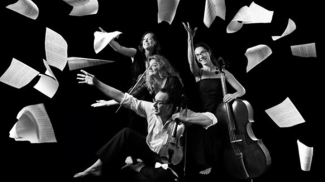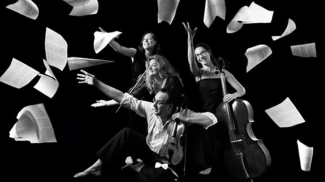Discovering Günter Raphael With Acacia Quartet

The musicians of Acacia Quartet will soon be packing their bags for Berlin as they begin a rare adventure discovering and performing the music of German-Jewish composer Günter Raphael.
Speaking to SoundsLikeSydney, Acacia cellist Anna Martin-Scrase explained that she and her colleagues, violinists Lisa Stewart and Myee Clohessy and violist Stefan Duwe have been invited by the Christine Raphael Foundation in Berlin, to perform and record three of Günter Raphael’s six string quartets.
Günter Raphael was born in Berlin in 1903 to a Jewish father Georg and Maria Becker, a violinist and daughter of Albert Becker, a noted Berlin composer and director of music at the Dom in Berlin. Georg, a composer and church musician anticipated trouble and converted to Protestantism, even working at the Luther Kirche in Berlin. Not surprisingly their son Günter also became a musician whose compositional output was prolific. His music was published by Breitkopf & Härtel. His portfolio included five symphonies and other orchestral works, concertos, instrumental works, chamber music and a large amount of choral and vocal music.
After his death in Germany in 1960, his daughter, Christine Raphael, also a violinist, formed the Christine Raphael Foundation “aiming to both boost the presence of Günter Raphael’s works in concerts, radio programs and on CDs as well as the musicological research of the entire legacy.” After her death in 2008, her husband Frederik Pachla took over the administration of the foundation which is curated by Raphael’s other daughter, Dagmar Pieschacón-Raphael.
Says Anna, “What appeals to us as an ensemble are his really lush harmonies and thick-textured writing. He was influenced by a spectrum of composers from the Romantics through to Schoenberg.”
As a composer, Raphael had three distinct phases of compositional style, explains Anna. “His early music to about 1934, is reminiscent of Brahms and Reger, a bit chromatic, full and passionate and big; in the second period he changed to a more a sparse texture – more rhythmic and more modal. In the third period which dates from about 1945, he experimented with a lot of twelve-tone tone music which he actually renamed ‘Tonal twelve-tone’.”
Raphael’s music is stored in his archive and some of it is commercially available. For this project, Frederik Pachla has provided the score for Acacia to work from. “Certainly one of the scores was only handwritten” observes Anna, “but the parts were all properly written out. One or two of the string quartets have been recorded in performance but not in a studio – and that’s what we’ve been asked to do.”
By all accounts, Günter Raphael was a precocious musician. He wrote his first composition, a short “Lied” for piano at the age of 10. He learned the viola and piano and studied chamber music with his mother. Aged 19, Raphael was awarded the Robert Schumann Leipzig Foundation Scholarship to the Hochschule für Musik in Berlin where he studied composition.
After his studies, Günter Raphael enjoyed considerable success as a composer and teacher. His String Quartet No1 in E minor was premiered by the Busch Quartet in Berlin in 1925. A year later, the same ensemble premiered his String Quartet No 2 in C major, after which he signed his first contract with Breitkopf & Härtel and moved to Leipzig where he taught theory and composition at the State Conservatory and where his Symphony No 1 was premiered by the Gewandhaus Orchestra, conducted by Wilhelm Furtwängler.
Although Georg had converted to Protestanstism, the Nazi’s determined that Raphael was a “half-Jew” and sadly, this brought a halt to his composing and to the performance of his music. He lost his teaching post at the Leipzig Conservatory in 1934 and later that year, he contracted tuberculosis requiring frequent treatment and rest which curtailed his activities even more.
Raphael survived the war, partly because his doctors hid him from the Nazis in the sanatoria. Yet, he never regained the prestige he enjoyed previously, despite being awarded the Liszt Prize by the City of Dresden in 1948. “He mentored colleagues through de-Nazification and formed a duo with his wife, Pauline, touring and performing extensively, explains Anna. “Eventually, he was appointed to a teaching post at the Duisberg Conservatorium. Ironically, Raphael was offered the post of Kantor at the Thomaskirche in Leipzig in 1956, an offer he declined because he felt the environment in East Germany would be too repressive. He was appointed lecturer at the Conservatory of Music in Mainz and at the Cologne Hochschule für Musik in 1957, teaching and working on new editions of Bach, Handel, Reger, Mozart and Gluck, but he died of tuberculosis shortly after, in 1960.”
Prior to their residency in Berlin, Acacia will travel to Essen for a week of intensive master classes with their mentor Emile Cantor, violist from the Orpheus Quartet. “This is probably the most exciting bit” says Anna. “From Essen, we will go to Berlin for three weeks where we have four concerts and three days of recording Raphael’s music.”
“Raphael plays with form” says Anna, excitedly, “The first string quartet has only two movements and the first movement is about 20 minutes long. It feels like there are more movements within it but he doesn’t stop or name them. It has a fugue as well so you can definitely hear bits of Bach in there. And the second string quartet that we’re performing in Berlin, unusually, has 5 movements. We have yet to play the String quartet No 6 so that’s going to be a revelation.”
“What’s most fascinating” she enthuses “is that he was extremely clever and intellectual. He grew up in an incredibly musical environment and was always trying to break out of the mould.”
Bon voyage Acacia!
Shamistha de Soysa for SoundsLikeSydney©
Acacia Quartet’s Berlin concerts will be performed at the Universität der Künste on May 4 and the Paulus-Saal, Gemeindehaus Pauluskirche on May 12. Two other concerts will be private events held under the auspices of the Raphael Society.
Acacia will be performing Raphael’s String Quartet No2 at the Bowral Autumn this weekend and the String Quartet No 1 at the Sydney Opera House on March 31.




